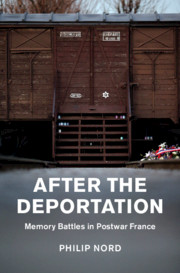Book contents
- After the Deportation
- Studies in the Social and Cultural History of Modern Warfare
- After the Deportation
- Copyright page
- Dedication
- Contents
- Figures
- Acknowledgments
- Abbreviations
- Introduction
- Part I Heroes and Martyrs
- 1 Le Parti des Déportés
- 2 The Concentrationary Universe
- 3 Monster with One Eye Open
- 4 The Triumph of the Spirit
- 5 The Six Million
- 6 The Thirty Years’ War
- Part II Shoah
- Epilogue and Conclusion
- Notes
- Index
2 - The Concentrationary Universe
from Part I - Heroes and Martyrs
Published online by Cambridge University Press: 16 November 2020
- After the Deportation
- Studies in the Social and Cultural History of Modern Warfare
- After the Deportation
- Copyright page
- Dedication
- Contents
- Figures
- Acknowledgments
- Abbreviations
- Introduction
- Part I Heroes and Martyrs
- 1 Le Parti des Déportés
- 2 The Concentrationary Universe
- 3 Monster with One Eye Open
- 4 The Triumph of the Spirit
- 5 The Six Million
- 6 The Thirty Years’ War
- Part II Shoah
- Epilogue and Conclusion
- Notes
- Index
Summary
The deepening of Cold War tensions led to a splintering of the deportee community. FNDIRP took the Soviet Union’s side in the conflict, opposing German rearmament and casting the fledgling German Federal Republic and its American sponsors as fascism’s postwar heirs. Ex-deportees of more centrist political views broke away and founded a counter-organization. The move was led by David Rousset, author of a classic analysis of camp life, L’Univers concentrationnaire (1946). For Rousset, it was not just the Nazis who were culpable of maintaining a camp system but the Soviets too (he was in fact the first to introduce the word Gulag into French common usage). Rousset crusaded under the banner of anti-totalitarianism, and the better to identify and to fight totalitarianism in whatever guise, he wanted the world to know what a genuine concentration camp looked like. To that end, he and the organization he helped to found, the Union nationale des associations de déportés, internés et familles de disparus, français, campaigned in the 1950s to create a national monument to the Deportation, located at Struthof in the Alsace, territory that had been annexed by the Reich during the war. The Struthof memorial complex (1960), located on the site of an actual concentration camp, turned the vestiges of the camp into an outdoor museum that both memorialized the résistants who had died there and stood in warning against any recrudescence of such totalitarian designs in the future.
Keywords
- Type
- Chapter
- Information
- After the DeportationMemory Battles in Postwar France, pp. 53 - 87Publisher: Cambridge University PressPrint publication year: 2020

